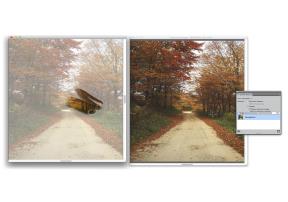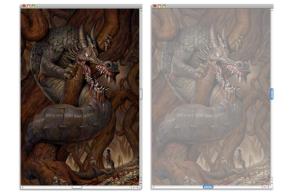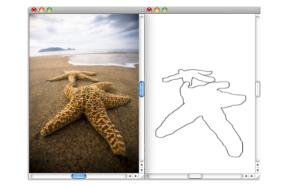Quick links to procedures on this page:
Corel Painter lets you clone an image to create a work of art. In other words, you can use cloning techniques to give your digital photographs a second life.
This section explains the manual process of cloning an image. The manual process involves choosing the image you want to clone (source image), creating the clone, and then setting up the workspace to start painting in the clone. However, if you prefer, you can choose a source image and let Corel Painter automatically set up the workspace for painting in the clone. For information, see Using Quick Clone.
Setting up the clone
To begin the cloning process, you need to select the source image that you want to clone. Corel Painter then duplicates this source image and embeds the image as a clone source in the clone document. The clone document appears in a new document window, and the clone source is displayed in the Clone Source panel. You can also open the source image in a separate window, which allows you to paint on the canvas with the source image displayed by its side. A crosshair cursor appears in the Source Image window to identify which area of the source image you are painting.

The area that is painted in the clone document window (left) is identified by a crosshair cursor in the Source Image window (right).
Working with the source image
The clone source image is best described as a snapshot of a selected image at a given time. Once the clone is created and the clone source image is embedded, the relationship with the original document is broken. However, you can edit the embedded clone source image to change its appearance. For more information, see Editing, updating, saving, and exporting clone source images.
Once the initial clone is created, you can add additional source images to the clone document, which allows you to clone colors from different sources. For more information, see Working with multiple clone sources.
When the clone document opens in the document window, you need to clear the canvas to begin painting in the clone by using the painterly technique of your choice. For more information, see Painting in the clone.
Cloning with tracing paper
Before you begin painting in the clone, you can also enable tracing paper. Tracing paper displays a faded-out version of the source image beneath the clone document, which lets you precisely apply clone colors to the canvas.
Unlike traditional tracing paper, the Corel Painter tracing paper is a viewing mode that you can use as a reference for painting or tracing images. It’s not a real object, such as a layer or a document. This viewing mode provides a faded-out version of the source image in the document window, as if it were displayed on top of a light box. When you apply media to the image with tracing paper enabled, the media is applied to the clone document, not the tracing paper.

The clone with the tracing paper turned on (right) allows you to see a faded-out image of the clone source image (left).
When the tracing paper is turned on, not all image details are clearly visible. To keep track of the changes, you may want to toggle between enabling and disabling the tracing paper. You can also control the opacity of the tracing paper.
Outlining with tracing paper
In addition to painting in a clone, you can use a clone with tracing paper enabled to outline an image. You can then use the outline as a starting point for a painting.

Use the tracing paper feature to view the source image for outlining (left). When you turn tracing paper off, you can see the outline (right).

When you create a clone, a copy of the source image is automatically embedded in the clone document. Consequently, if you make changes to the original image, the changes are not reflected in the clone. If you want to use the most up-to-date version of the image, you need to add it as a new clone source and then delete the older version. For more information, see To update changes to a clone source image.
If a source image has layers, cloning creates a fully composited copy — that is, all layers in the image are dropped automatically. This aspect of cloning lets you flatten an image for faster printing.
If you select a Cloner brush and switch to offset sampling while cloning an image, the Offset Sampling check box is automatically enabled in the Clone Source panel. It is also important to note the sampling reference point is not treated as a clone source and does not display in the Clone Source panel. For more information, see Performing offset sampling.
|
2
|
In the Clone Source panel, enable the Show Source Image (with crosshair cursor) check box. |
|
2
|
In the Clone Source panel, click the Toggle Tracing Paper button  . . |
|
|
|
|
|
In the Clone Source panel, adjust the Set Tracing Paper Opacity slider.
|
|
|
In the Clone Source panel, click the Toggle Tracing Paper button.
|

You can also enable tracing paper from the Navigator panel by clicking the Open Navigator Settings button  and choosing Tracing Paper.
and choosing Tracing Paper.
Copyright 2014 Corel Corporation. All rights reserved.

![]() and choosing Tracing Paper.
and choosing Tracing Paper.